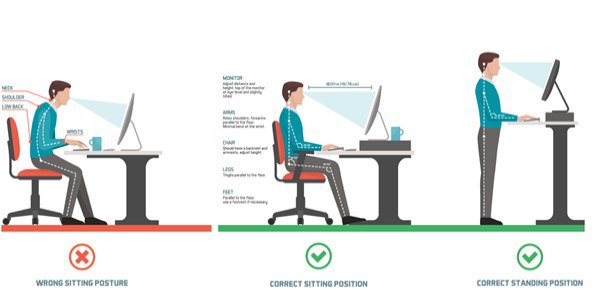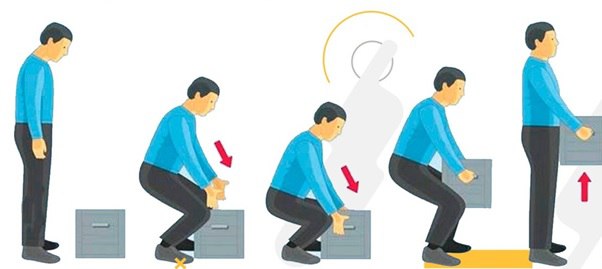Ergonomics Workplace Analysis
Physiotherapy plays a pivotal role in ergonomics by integrating principles of body mechanics, posture, and movement to design workplace environments that promote health, productivity, and injury prevention. Physiotherapists specialize in understanding human movement and can provide tailored solutions to optimize the physical demands of various work settings.
Contributions of Physiotherapy in Ergonomics
1. Workplace Assessments
- Observation and Analysis: Physiotherapists analyze workstations and job tasks to identify risk factors for musculoskeletal injuries.
- Customization: Tailored modifications are suggested for tools, furniture, and workflows to match individual needs and job requirements.
2. Injury Prevention
- Postural Education: Training employees on maintaining proper posture during work activities, reducing strain on muscles and joints.
- Body Mechanics Training: Teaching techniques for safe lifting, bending, and repetitive tasks to prevent injuries.
- Ergonomic Recommendations: Guidance on using ergonomic equipment like adjustable chairs, keyboards, and sit-stand desks.
3. Rehabilitation and Recovery
- Treatment of Work-Related Injuries: Providing physiotherapy interventions such as manual therapy, exercises, and modalities to treat conditions like back pain, carpal tunnel syndrome, and repetitive strain injuries.
- Return-to-Work Programs: Designing graduated return-to-work plans that ensure a smooth transition after injury recovery.
4. Workplace Wellness Programs
- Stretching and Exercise Routines: Introducing workplace exercises to improve flexibility, strength, and circulation.
- Stress Management: Incorporating relaxation techniques, breathing exercises, and mindfulness to address mental and physical stress.
5. Ergonomic Training for Employers and Employees
- Awareness Building: Conducting workshops and training sessions on ergonomic principles and the importance of a safe work environment.
- Self-Assessment Tools: Teaching employees how to assess and adjust their workstations independently.
Benefits of Physiotherapy in Ergonomics
- Reduces the incidence of workplace injuries and absenteeism.
- Improves employee productivity and comfort.
- Promotes long-term musculoskeletal health.
- Enhances workplace morale and satisfaction by addressing health and safety concerns.
Physiotherapy Management: Tailored Solutions by Profession
Ergonomics is critical to optimizing workplace setups, minimizing strain, and preventing musculoskeletal disorders across various professions. Physiotherapy management offers practical strategies for analyzing and improving workplace ergonomics tailored to specific job roles, including IT employees, bank employees, corporate workers, teachers, professors, and industrial laborers.
1. IT Employees
Common Issues:
- Prolonged sitting leading to neck, back, and shoulder pain.
- Wrist and hand strain from keyboard/mouse use (e.g., carpal tunnel syndrome).
- Eye strain from excessive screen exposure.
Ergonomic Strategies:
- Workstation Design:
- Adjustable chairs with lumbar support.
- Ergonomic keyboards and mouse to reduce wrist strain.
- Monitor placement at eye level to avoid neck strain.
- Physiotherapy Interventions:
- Stretching routines for the neck, shoulders, and lower back.
- Postural correction exercises.
- Strengthening exercises for core stability.
2. Bank Employees
Common Issues:
- Static postures during prolonged sitting or standing.
- Repetitive tasks like typing or counting cash leading to wrist and shoulder pain.
- Stress-related muscular tension.
Ergonomic Strategies:
- Workstation Design:
- Adjustable chairs with armrests.
- Proper desk height for cash handling and typing.
- Physiotherapy Interventions:
- Regular breaks for movement and stretches
- Exercises to alleviate wrist and shoulder stiffness.
- Relaxation techniques to manage stress-related tension.
3. Corporate Workers
Common Issues:
- Desk jobs with minimal movement, leading to poor posture.
- Long meetings causing stiffness.
- Increased mental stress contributing to muscular tension.
Ergonomic Strategies:
- Workstation Design:
- Sit-stand desks for posture variation.
- Footrests to reduce lower back strain.
- Physiotherapy Interventions:
- Office-based stretching programs.
- Breathing exercises to reduce stress.
- Recommendations for ergonomic chairs.

4. Teachers and Professors
Common Issues:
- Standing for long periods leading to leg and lower back discomfort.
- Voice strain from prolonged speaking.
- Poor seating during grading and administrative tasks.
Ergonomic Strategies:
- Workstation Design:
- Anti-fatigue mats for standing work.
- Adjustable podiums for teaching.
- Ergonomic chairs for seated tasks.
- Physiotherapy Interventions:
- Leg stretches and strengthening exercises.
- Postural training for prolonged standing.
- Voice projection techniques to reduce vocal strain.
5. Industrial Laborers
Common Issues:
- Repetitive lifting causing back and shoulder injuries.
- Exposure to vibrations from tools leading to hand-arm vibration syndrome.
- Poor working posture leading to chronic pain.
Ergonomic Strategies:
- Workplace Design:
- Use of lifting aids and adjustable workstations.
- Anti-vibration gloves for tool use.
- Proper lighting to reduce eye strain.
- Physiotherapy Interventions:
- Training on proper lifting techniques.
- Core strengthening exercises for injury prevention
- Rehabilitation for repetitive strain injuries.
